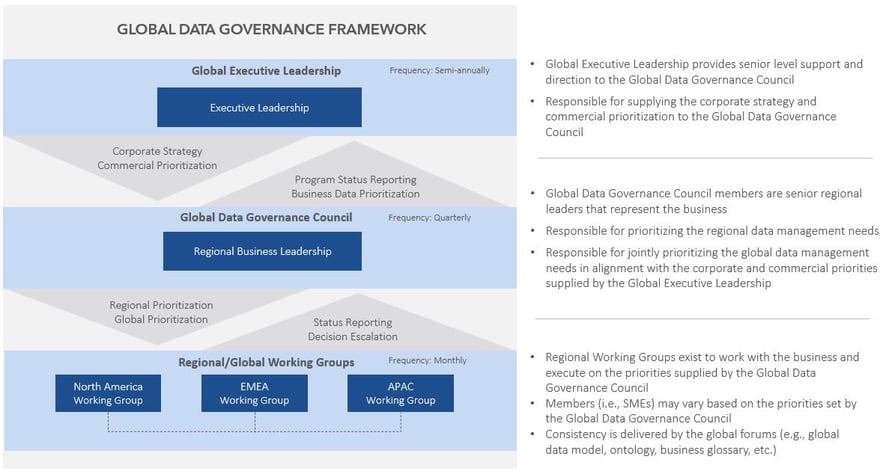
“Great moments are born from great opportunity, and that’s what you have here…” This is one of my favorite quotes, from USA Olympic Hockey legend, Herb Brooks, as he addressed his team just before the historic 1980 game vs the Soviet Union. That was an opportunity (always worthy of repeating) his team seized!
As discussed in David Bates’s latest blog Building a Next Generation Data Architecture, every decade or so, an asset manager has the opportunity to redefine the tools, systems, people, and governance required to serve the data needs of their portfolio managers, clients, and other stakeholders. But how many organizations will truly seize the opportunity to restructure, or in some cases, implement a new data governance framework?
When the benefits of major transformation programs are discussed, there is a lot of attention paid to technological advances in cloud computing, storage, and data analytics as well as changes in outsourcing processes with strategic partners. These elements will enable an organization’s product strategy/growth, but it is a well-defined data governance framework that will support it long-term as the business evolves.
There are multiple facets to a data governance framework, but successful programs share four key components: executive sponsorship, business leadership/prioritization, technology support and alignment, and subject matter experts working together to deliver it. It is often a misconception that data governance is a technology responsibility; in fact, it is a business-led function since the business owns the data. Therefore, the business has the responsibility to define the policies and standards for their data and it is technology’s role to provide the tools and controls to enforce them.
Quality and controls are obvious components of data governance, but it also involves being able to answer some basic questions for your organization, such as:
- Where is the gold copy of “this” data?
- How do I get access to it?
- Who owns the data if I have questions?
Data domain definitions help organizations resolve and answer those questions. Data domains are high-level categories of institutional data which have been defined for the purpose of assigning accountability and responsibility for the data. Each domain is aligned with a business function, like trades, positions, performance, etc. A recent client experience may help to explain how it answered these questions and avoided creating another data management and support problem.
Data Domain Case Study
Effective data governance ensures that data is consistent, trustworthy, and properly supported. In this case study, a client's European business group was migrating off a proprietary risk analytics system onto a new vendor application. As part of their gap analysis, the implementation team identified a missing data point that was derived in the legacy system and sent to the OMS prior to trading. The implementation team requested that the missing data point be sourced and derived in the global data warehouse, which was the wrong data domain to be sourcing this data. Since this client was in the process of defining their data domains, they worked through the exercise of asking and understanding these questions:
- What type of data is it? To understand which data domain, it belongs
- Answer: A private equity attribute
- Which business group owns this data? To ask questions and receive direction on how the data is managed and supported
- Answer: The Alternatives team based in North America
- How do they manage this data? To understand the systems and processes used to support it
- Answer: In a private equity fund admin system
As a result, they were able to source the data the trading team needed, from the correct data domain, and avoided creating another custom process and workflow in the data warehouse.
An unintended benefit from this experience is that it opened a dialogue between two business groups that didn’t previously communicate. The data governance framework provided the operational model and processes for the organization to follow and their data domain definitions provided the means to connect to the business owners and data they needed.
The data governance framework for this client worked well because it was aligned with the way the client conducts their business. In Colleen Devin’s recent blog Transformation Programs: Are They Missing the Mark? she emphasizes a similar point that organizational and operational models need to align with how an organization conducts business in their current and future state models. The same applies for a data governance organizational structure. This client was transforming their operating model from a global organization acting regionally, to a global organization acting globally and servicing clients regionally.

The graphic above depicts a simplified version of how a global organization may choose to construct their data governance framework. The Global Executive Leadership is responsible for providing the corporate strategy and the regional/global commercial prioritization to the Global Data Governance Council. The members of the Global Data Governance Council are senior regional leaders that represent the business and are responsible for defining prioritization for the Regional/Global Working Groups. The members of the working groups are subject matter experts, and attendees may vary based on the priorities set by the governance council. Technology is represented at each level of the framework to provide the tools and controls to support the business.
Most firms only have the appetite to conduct a transformation program once a decade as they can be costly and disruptive endeavors for any organization. Make sure you seize the opportunity to take control and govern your data. “Great moments are born from great opportunity, and that’s what you have here.” It may be a while before you get another opportunity.










Comments